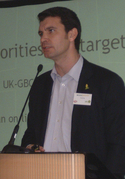Look to the future
24 November 2007TTJ's Wood Future conference, sponsored by the Medite 2016 Forum, and supported by TRADA, provided much food for thought
Summary
• TTJ’s Wood Futures conference was held on November 8.
• It was sponsored by Medite 2016 and supported by TRADA.
• The keynote speaker was environment minister Phil Woolas.
• Louise O’Neill outlined Marks & Spencer’s Plan A eco-strategy.
• Rupert Scott flagged up potential changes to codes and regulations.
If ever proof were needed that timber is rising to the top of the political agenda, it was provided by the keynote speaker at TTJ’s Wood Futures – Sustainable Solutions conference at the Royal Festival Hall in London on November 8.
Environment minister Phil Woolas addressed an audience of around 110 delegates and told them “the issue of sustainability and sustainable timber comes into every government policy”. Setting his address against a backdrop of the “60 million people worldwide who are entirely dependent on forestry for their livelihoods” and the fact that “only 8% of the forest is certified and the rate is slowing,” Mr Woolas went on to outline government procurement policy.
“As a government we must demonstrate best practice and stimulate markets by leading by example,” he said. Government spending accounts for around 10% of the UK’s consumption of timber, he said, but the effect of this is much more significant than that figure would suggest. “It’s the single most important driver for taking illegal timber out of the supply chain.”
He acknowledged the work already done by the UK forest products industry in terms of the fight against illegal logging: “Our knowledge and reputation is very high and we will continue to show that the UK is a world leader,” he said. “Industry has demonstrated increasing leadership,” he continued. Forty-five per cent of timber by volume is responsibly purchased and 60% of imported timber in the UK is certified. “There is good interest in reducing the length of the supply chain and establishing partnerships, which will reduce the risk of illegal timber,” he said.
“The timber industry claims it is the leading construction material, but the more we can prove that, the better for us,” said Mr Woolas. “Industry’s role in the environmental economy is increasingly important and there must be a relationship between industry and government,” he concluded.
Adding some more detail to the environment minister’s address, Jenny McInnes, Defra policy adviser, brought delegates up to speed with progress at the Central Point of Expertise on Timber (CPET). The recent formal consultation period with industry, the results of which will be presented at the next board meeting, had provided “very useful feedback”, she said.
A construction sector pilot study also proved illuminating. Recommendations will be presented to government shortly but will include the need to increase awareness of timber procurement policy at ground level, and to improve the reporting frameworks that monitor how well the policy is being implemented.
Environmental opportunity
Other speakers focused on the opportunities to capitalise on the growing hunger for environmentally-sound products and practices.
Louise O’Neill, supplier exchange manager in Marks & Spencer’s Corporate Social Responsibility team, outlined the company’s Plan A – a £200m environmental strategy that hit the national media headlines earlier this year.
For M&S, gaining the trust of its customers is paramount and, she added, 80% of its customers are now interested in ethical issues. “Customers now worry more and trust less,” said Ms O’Neill, “and we’ve had to work hard to overcome the negative headlines.” As an example, she said, 95% of M&S’s garden furniture is now FSC certified and one of the targets of the 100-point eco-plan is that, in five years time, all the timber used by M&S will be recycled or certified under the FSC scheme, which currently is the only certification programme it endorses.
Other 2012 targets are that M&S becomes carbon neutral; sends no waste to landfill; extends its sustainable sourcing; sets new standards in ethical trading; and helps customers and employees live a healthier lifestyle. And, added Ms O’Neill, “there’s no Plan B – we’re putting our necks on the line with Plan A”.
Construction goes green
As Paul King, chief executive of the UK Green Building Council (GBC), explained, his organisation was set up because of the growing interest in environmentally-sound building practices and the need for a “coherent strategy and clarity of leadership”.
GBC’s role, he said, is to be proactive with government, presenting it with simple propositions and a willingness to cope with ambitious targets and mandatory regulations, but urging it to engage with the organisation at the earliest possible stages of development so that the demands aren’t “prescriptive”.
GBC task groups would be deployed to achieve its target of reducing the built environment’s carbon footprint by 80% by 2040, said Mr King.
To get an alternative industry perspective on sustainability issues, Wood Futures also invited Guy Thompson, head of architecture and housing at the Concrete Centre, to address the conference. He said the concrete sector is addressing the new agenda “with enthusiasm” and aims to be at zero carbon by 2016. Cement replacement, use of secondary and recycled aggregates and waste disposal are all areas being researched, he said.
He added that his organisation did not want to do battle with the timber sector over which was the more sustainable. “Most architects are trained to look at all materials; there is a place for all of them in construction. I don’t understand the war between them”.
“It’s counter-productive for designers who are more interested in producing sustainable, coherent designs,” he added. “I want a sustainable future; concrete will play its part, but it won’t be the only participant.”
Olympic procurement policy
Of the many target dates on the horizon, 2012 is one that stands out – particularly for Dr Peter Bonfield, BRE chief executive and leader for construction products at the Olympic Delivery Authority (ODA), the organisation responsible for organising the building of everything bar the Olympic Village.
Dr Bonfield outlined the procurement policy that ODA would enforce within its “tier one” suppliers. Those tier one suppliers would then be expected to feed those principles and requirements down through several more tiers. An approved supplier list will be set up and all contractors and sub-contractors will be expected to source from it.
“We will have around 250 main contracts, around 2,000 smaller ones and then many thousands through the sub-contractors,” he said, adding that a company’s ability to demonstrate sustainability accounts for up to 30% of the total marks for a tier one contract.
“Our starting point is that every bit of wood – from scaffold boards and shuttering to glulam beams – is sustainably sourced,” said Dr Bonfield. “Ten months ago there wasn’t the capacity in the industry to cope with this demand. However, it’s delightful that a number of companies have now improved their capacity in order to supply. This is a really important step change for the industry and has given the ODA the confidence to say that every piece of timber can and will be sustainably sourced.”
“I’m not aware of any other project in the world that has such demanding criteria,” he said. “But I make one request: if you get on this [approved supplier] list, don’t let us down. “
Environmental NGOs have consistently high expectations of the forest products industry and, as George White, a consultant with WWF’s Global Forest and Trade Network (GFTN) said, there have been some significant achievements.
“Certification has a very meaningful role to play in our industry and it’s come a long way in the last few years. Our work at GFTN is very much about working with industry – we have common vested interests and no longer stand on the sidelines, fighting it out.”
But, he said, there is still a long way to go. “Threatened and vulnerable forests aren’t easy to certify, but there’s no alternative. If they’re not protected, they will disappear. The future will consist of companies that live in the real world and fix the supply issues, and others who stick their heads in the sand.”
Cracking the codes
As Rupert Scott, regulation and codes consultant at TRADA pointed out, no-one can have failed to notice that environmental issues are driving fundamental market changes. “The challenge is that it’s all happening at once. Changes need to be implemented quickly and simultaneously – there’s a real sense of urgency.”
He added that “sustainability is a much bigger issue than responsible purchasing” and is influenceing changes to codes and regulations in a range of areas. Among these he flagged up acoustics; reduction in water consumption; energy (with many targets, such as zero carbon being fed into Part L); accessibility (Part M), with all the space implications of designing dwellings for the less able-bodied; security (Secured by Design is likely to appear in private housing); and waste reduction – the proposed target is zero waste to landfill by 2020.
“Like it or not, government is defining our market,” he said. “And using codes and standards to do it.”
For Professor Michael Benfield, managing director of timber frame construction specialist Benfield ATT, the challenges set by government include the target of 250,000 new sustainable homes per year.
Timber construction is set to benefit, he said, but key topics needed addressing, including fire safety during construction and flood damage. “We need to capitalise on timber frame’s quick drying capabilities, but we also need to look at developing water resistant, or at the very least, water stable, timber,” he said.
Timber suppliers must be essential supply chain partners, he said, not just commodity suppliers.
A “shared common approach to sustainable supply chains”, was also the goal for Travis Perkins (TP), according to its group environmental manager Jez Cutler. He called for more transparency within the supply chain: “Open communication is key,” he said.
While wider society is interested in a correspondingly wide range of green issues, TP's customers are more interested in specific, product-related issues.
Carbon critical
“Product stewardship is our main area of communication to customers,” he said. “And it’s impossible to over-emphasise the importance of carbon. At TP we’re not talking about carbon labelling yet, but we are talking about carbon measurement because customers are asking the carbon value of various products.
“We don’t know the answer at the moment and we’re going to need a lot more help from the timber industry,” he added. “Unless we can prove timber is a low carbon product, we’re not going to be able to sell it. The ‘trust us’ approach isn’t going to work – the low carbon angle needs independent corroboration.”
The final two presentations covered the global and UK forest resource. While Europe’s forests are in “a comparatively good state”, “there is a big job to do on certification in the tropics,” according to Dr Ed Pepke, forest products marketing specialist in the Timber Section of the UN ECE/FAO. And, he said, the entire forest resource is being changed by the demand for bioenergy which, in particular, is leading to deforestation in tropical regions.
“Deforestation accounts for 20% of greenhouse emissions and we won’t solve this easily,” added Forestry Commission director-general Tim Rollinson.
“Climate change dominates my life at the moment,” he said, “and in five years time everyone here will be involved with carbon management.”
Wood Futures presentations will be published in full by TTJ with the Medite 2016 Forum.












